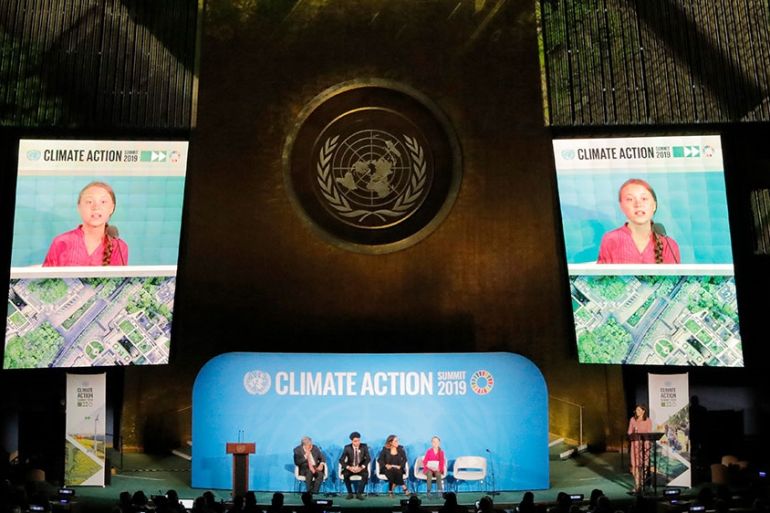How will Greta Thunberg cross the Atlantic for COP25 in Madrid?
The young Swedish climate activist seeks an environmentally friendly way to travel back to Europe from North America.

Climate campaigner Greta Thunberg has suddenly found herself on the wrong side of the Atlantic, after Spain replaced protest-hit Chile as the host of next month’s United Nations climate talks.
With just a few weeks to go before the gathering starts on December 2, the Swedish teenager – who does not fly for environmental reasons – put out an urgent call to her Twitter and followers to find a low-emission way back to Europe.
Keep reading
list of 4 itemsAfter the Hurricane
Photos: Dubai reels from flood chaos as record rains lash UAE
Ecuador declares energy emergency amid severe regional drought and El Niño
After recent stops in South Dakota, British Columbia and California, on Monday Thunberg tweeted from Texas that she was “traveling east through the beautiful southern states in the USA” to reach the East Coast and, hopefully, find a relatively quick ride to Madrid.
On Friday, fellow activist Jamie Margolin responded to Thunberg’s Instagram post after a student strike in Los Angeles: “Girl same I’m trying to figure out what I’m gonna do for COP [climate conference] but it’s okay we will figure something out!”
A couple months after Thunberg hitched a lift on a racing yacht to the United States, here are five options she might consider for her return voyage – with some more economical than others:
Racing yacht
Thunberg travelled to New York City for the UN General Assembly on the Malizia II, a state-of-the-art, zero-emissions racing yacht.
The vessel was fitted with solar panels and underwater turbines to produce electricity and took nearly 14 gruelling days to reach New York – with big waves often tossing around Thunberg’s entourage.
But the crossing was planned for months, and the yacht was manned by two highly experienced sailors to make the journey safely. There was also no toilet or shower and passengers ate freeze-dried food.
And it is unclear whether another crossing could be organised at such short notice.
However, if the crew were required to fly to New York to help Thunberg make the journey, it might cancel out the emissions savings from her travelling in the boat.
One Twitter user, an Irish climate activist, mentioned that a number of racing yachts are to arrive in South America this week and might be capable of stopping in North America before heading back to Europe.
Cargo ship
The most eco-friendly option might be to travel by cargo ship, according to Roger Tyers, a research fellow in environmental sociology at the University of Southampton in the United Kingdom, from which Thunberg initially sailed.
Between 2007 and 2012, shipping accounted for about three percent of the world’s carbon emissions, according to the International Maritime Organization.
Joining a ship on its already-scheduled journey would have a negligible effect on the vessel’s emissions, Tyers said.
Tristan Smith of University College London said several shipping companies offer berths for passengers.
“This used to be quite a common means of travel,” he said. “Many lines have plenty of experience.”
Rowboat
If larger vessels are unavailable, Thunberg could consider making the 3,000-mile (4,800km) journey by rowboat.
Such a journey was first completed by Frank Samuelsen and George Harbo, who rowed from New York to Britain’s Isles of Scilly in 1896.
A similar trip – in the other direction – will be taken by the participants in the annual Talisker Whisky Atlantic Challenge, who will be rowing from Spain’s Canary Islands to Antigua and Barbuda in early December.
Aeroplane
The activist promised to make her journey without flying, but that option may be the easiest to arrive in time for the next global gathering to halt climate change.
Thunberg could offset her flight emissions by using one of several schemes offered by major airlines. But Tyers, the academic, said the young hardy Swede should be wary.
“The problem with carbon offsets is that they can create a kind of moral licence for us to maintain our polluting lifestyles,” he said.
The best carbon offsetting schemes are the least photogenic, according to Tyers. Rather than donating to tree-planting initiatives, travellers should fund carbon capture and storage programmes such as those collecting methane gas from landfill sites and abandoned mines.
Other possible offset projects could involve financing for renewable power sources, which reduce the carbon intensity of the electricity supply or building efficiency improvements that decrease the overall demand for energy.
At present, solar-powered planes are not yet commercially available and the introduction of biofuels into the aviation industry – whether from palm oil or waste gas – has been painfully slow.
Swimming
Numerous people claim to have swum across the Atlantic.
In 1998, French-born swimmer Benoit Lecomte swam – in stages – from the US state of Massachusetts to France over several months, claiming to be the first man to swim across the Atlantic without a kickboard.
Lecomte was accompanied by a sailboat that emitted an electromagnetic field to keep away sharks, and a crew of three. He spent about eight hours swimming per day and would rest and eat on board the boat.
In 2009, the American swimmer Jennifer Figge became the first woman on record to perform a similar feat after swimming several stretches of the ocean in 24 days. Her journey included a shark cage, but strong winds blew her way off course from her planned destination of the Bahamas, and landed her in Trinidad instead.
A tenacious Scandinavian, Thunberg would need to be escorted by a boat to protect her from underwater dangers and give her somewhere to regain energy. With the emissions of a supply boat behind her, this option might not really be the most eco-friendly for someone hoping to avoid using fossil fuels.